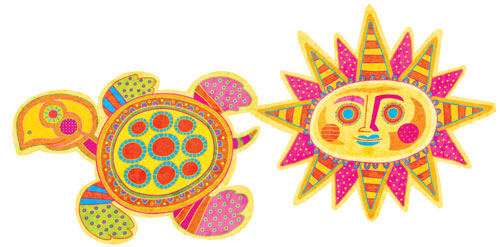Designer Spotlight: Lee Calderon

Lee Calderon was born in Southern California, where he lived, dreamt up designs, and created art, until moving to colorful Colorado about four years ago. His creative journey began, perhaps like most budding artists, closely surrounded by a stack of papers and loads of crayons. In fact, even to this day, those he encounters swear he smells like a box of crayons—or, at least, to his kids anyway. Shortly after studying architecture, Lee’s passion for Gothic arches and flying buttresses gave way to his undeniable artistic urges and “designful” nature. It was also about this time that he swapped out his jars of cobalt blue and cadmium red for pixels and vector art.

Over the years, Lee has created original digital artwork for various venues, such as greeting cards, magazine publications, posters, ad campaigns, gameboards, children’s picture books, and more. Aside from his artwork, he has created designs for many forms of visual communication, such as logos, brochures, corporate identities, brand designs, ad campaigns, in-store graphics, and how-to books. Lee’s long list of clients includes Jose Cuervo International, Hallmark, Fisher-Price, Parents Magazine, and Random House/Tricycle Press.
Layers: You earned a Bachelor of Architecture degree from Cal Poly Pomona in California. What drew you to an education in architecture, and what was it about illustration and design that pulled you away from architecture after earning a five-year degree?
Calderon: My father was an architect and I have fond memories of when I was very young drawing under his drawing table at home, while he was drawing houses, trees—things like that. I guess it was a natural progression to eventually go on to study architecture. After a brief stint working as an architect, I soon felt that my “canvas” was not as colorful, conceptual, or creatively challenging as I had hoped. It was about then that a field trip to Art Center College of Design in Pasadena, California, changed my life. It was going to be all about art and design from now on.

Layers: How would you describe your illustrative style? How did your style evolve? Were you influenced by any famous artists?
Calderon: I love color, patterns, lines, and shapes. I like to think of these fundamental elements as my palette. When I think about it, I sometimes feel as though my initial passion for architecture never fully left me. My work has an architectural sense about it—playing with scale, harmony, layers, spaces, structure, contrast, balance, energy, and of course, some random playfulness. I’ve come to think of my artwork as a celebration of “the architecture of things.” I am quite fascinated by the process of constantly interpreting the things around me, which is probably why one of my most favorite quotes is one by Pablo Picasso: “I do not paint what I see. I paint what I know.”
Layers: You’re currently working on two wall-size graphics for the Loveland Public Library? Have you ever, literally, worked on a project this large before? What are some of the challenges for creating graphics that will be output at such a large size?
Calderon: This is the first time working on something of this physical size. The main thing to consider is the scale of the various elements throughout the piece—line weights, focal points, hierarchy, proportions—things like that. I really hope to continue creating many more large-scale pieces for public spaces.
Layers: Your website features some of your incredible design work. Do you prefer illustration to design, or do you like a balance between the two?

Calderon: I really do enjoy the balance of both disciplines. I think one feeds off the other. I just love the challenge and contrast of creatively balancing structure and freedom in both my artwork and design. I really think the journey is about getting to know who you are, who you’ve always been, listening to your inner voice, and of course, the client’s outer voice.
Layers: Which applications do you use for both your illustration and design work?
Calderon: My artwork is primarily vector-based, so I work in Adobe Illustrator CS4. Occasionally, I’ll mix in some Photoshop for additional masking, textures, etc. For my design work, I pretty much stick with InDesign, Illustrator, and Photoshop CS4. As for CS5, I’ve seen some of the promotional videos and am fully convinced that magic is real.

Lee Calderon www.leecalderon.com
ALL IMAGES BY LEE CALDERON


